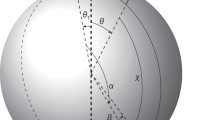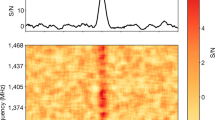Abstract
Magnetars1,2 are a special class of slowly rotating (period ∼5–12 s) neutron stars with extremely strong magnetic fields (>1014G)—at least an order of magnitude larger than those of the ‘normal’ radio pulsars. The potential evolutionary links and differences between these two types of object are still unknown; recent studies, however, have provided circumstantial evidence connecting magnetars with very massive progenitor stars3,4,5. Here we report the discovery of an infrared elliptical ring or shell surrounding the magnetar SGR 1900+14. The appearance and energetics of the ring are difficult to interpret within the framework of the progenitor’s stellar mass loss or the subsequent evolution of the supernova remnant. We suggest instead that a dust-free cavity was produced in the magnetar environment by the giant flare emitted by the source in August 1998. Considering the total energy released in the flare, the theoretical dust-destruction radius matches well with the observed dimensions of the ring. We conclude that SGR 1900+14 is unambiguously associated with a cluster of massive stars, thereby solidifying the link between magnetars and massive stars.
This is a preview of subscription content, access via your institution
Access options
Subscribe to this journal
Receive 51 print issues and online access
$199.00 per year
only $3.90 per issue
Buy this article
- Purchase on Springer Link
- Instant access to full article PDF
Prices may be subject to local taxes which are calculated during checkout

Similar content being viewed by others
References
Duncan, R. C. & Thompson, C. Formation of very strongly magnetized neutron stars: implications for gamma-ray bursts. Astrophys. J. 392, L9–L13 (1992)
Woods, P. M. & Thompson, C. in Compact Stellar X-ray Sources (eds Lewin, W. H. G. & van der Klis, M.) 547–586 (Cambridge Univ. Press, Cambridge, UK, 2006)
Figer, D. F., Najarro, F., Geballe, T. R., Blum, R. D. & Kudritzki, R. P. Massive stars in the SGR 1806–20 cluster. Astrophys. J. 622, L49–L52 (2005)
Gaensler, B. M. et al. A stellar wind bubble coincident with the anomalous X-ray pulsar 1E 1048.1–5937: are magnetars formed from massive progenitors? Astrophys. J. 620, L95–L98 (2005)
Muno, M. P. et al. A neutron star with a massive progenitor in Westerlund 1. Astrophys. J. 636, L41–L44 (2006)
Kouveliotou, C. et al. An X-ray pulsar with a superstrong magnetic field in the soft γ-ray repeater SGR 1806–20. Nature 393, 235–237 (1998)
Gaensler, B. M., Slane, P. O., Gotthelf, E. V. & Vasisht, G. Anomalous X-ray pulsars and soft gamma-ray repeaters in supernova remnants. Astrophys. J. 559, 963–972 (2001)
Eikenberry, S. S. et al. Possible infrared counterparts to the soft gamma-ray repeater SGR 1806–20. Astrophys. J. 563, L133–L137 (2001)
Heger, A., Fryer, C. L., Woosley, S. E., Langer, N. & Hartmann, D. H. How massive single stars end their life. Astrophys. J. 591, 288–300 (2003)
Frail, D. A., Kulkarni, S. R. & Bloom, J. S. An outburst of relativistic particles from the soft gamma-ray repeater SGR 1900+14. Nature 398, 127–129 (1999)
Kaplan, D. L., Kulkarni, S. R., Frail, D. A. & van Kerkwijk, M. H. Deep radio, optical, and infrared observations of SGR 1900+14. Astrophys. J. 566, 378–386 (2002)
Vrba, F. J. et al. The double infrared source toward the soft gamma-ray repeater SGR 1900+14. Astrophys. J. 468, 225–230 (1996)
Vrba, F. J. et al. The discovery of an embedded cluster of high-mass stars near SGR 1900+14. Astrophys. J. 553, L17–L20 (2000)
Hurley, K. et al. ASCA discovery of an x-ray pulsar in the error box of SGR 1900+14. Astrophys. J. 510, L111–L114 (1999)
Draine, B. T. Interstellar dust grains. Annu. Rev. Astron. Astrophys. 41, 241–289 (2003)
Morris, P. W. et al. Tentative discovery of a new supernova remnant in Cepheus: unveiling an elusive shell in the Spitzer Galactic First Look Survey. Astrophys. J. 640, L179–L182 (2006)
Chan, K. W. & Onaka, T. A broad 22 micron emission feature in the Carina Nebula H II region. Astrophys. J. 533, L33–L36 (2000)
Smith, N., Bally, J. & Walawender, J. And in the darkness bind them: equatorial rings, B[e] supergiants, and the waists of bipolar nebulae. Astron. J. 134, 846–859 (2007)
Weis, K. On the structure and kinematics of nebulae around LBVs and LBV candidates in the LMC. Astron. Astrophys. 308, 67–71 (2003)
Gruendl, R. A., Chu, Y.-H., Dunne, B. C. & Points, S. D. A morphological diagnostic for dynamical evolution of Wolf–Rayet bubbles. Astron. J. 120, 2670–2678 (2000)
Crowther, P. A. Physical properties of Wolf–Rayet stars. Annu. Rev. Astron. Astrophys. 45, 177–219 (2007)
Cox, A. N. Allen’s Astrophysical Quantities 4th edn (ed. Cox, A. N.) Ch. 7.5 15.3.1 (Springer, New York, 2000)
Koo, D.-C. & Heiles, C. A fast expanding H I shell in W44: A preexisting wind-blown shell overtaken by a supernova remnant. Astrophys. J. 442, L679–L684 (1995)
Wachter, S., Kouveliotou, C., Patel, S., Figer, D. & Woods, P. Spitzer space telescope observations of SGR and AXP environments. Astrophys. Space Sci. 308, 66–71 (2007)
Waxman, E. & Draine, B. T. Dust sublimation by gamma-ray bursts and its implications. Astrophys. J. 537, 796–802 (2000)
Fruchter, A., Krolik, J. H. & Rhoads, J. E. X-ray destruction of dust along the line of sight to gamma-ray bursts. Astrophys. J. 563, 597–610 (2001)
Tanaka, Y. T. et al. Comparative study of the initial spikes of soft gamma-ray repeater giant flares in 1998 and 2004 observed with Geotail: do magnetospheric instabilities trigger largescale fracturing of a magnetar’s crust? Astrophys. J. 665, L55–L58 (2007)
Palmer, D. A. et al. A giant gamma-ray flare from the magnetar SGR 1806–20. Nature 434, 1107–1109 (2005)
Hartmann, D. H. et al. On Flamsteed’s supernova Cas A. Nucl. Phys. A 621, 83–91 (1997)
Stratta, G. et al. Extinction properties of the X-ray bright/optically faint afterglow of GRB 020405. Astron. Astrophys. 441, 83–88 (2005)
Acknowledgements
This work is based on observations made with the Spitzer Space Telescope, which is operated by the Jet Propulsion Laboratory (JPL), California Institute of Technology (Caltech), under a contract with NASA. Support for this work was provided by NASA through an award issued by JPL/Caltech. This publication also makes use of data products from the Two Micron All Sky Survey, which is a joint project of the University of Massachusetts and the Infrared Processing and Analysis Center/Caltech, funded by NASA and the NSF. J.G. gratefully acknowledges a Royal Society Wolfson Research Merit Award. V.V.D. acknowledges support from the NSF and discussions with R. McCray, A. Crotts and R. Chevalier. D.F. acknowledges support from NASA through the Long Term Space Astrophysics programme, and by the New York State Foundation for Science, Technology, and Innovation Faculty Development Program grant.
Author information
Authors and Affiliations
Corresponding author
Supplementary information
Supplementary Data
The file contains Supplementary Data which includes additional details regarding the light echo scenario, the dust heating considerations, and the flare energetics and anisotropy. (PDF 95 kb)
Rights and permissions
About this article
Cite this article
Wachter, S., Ramirez-Ruiz, E., Dwarkadas, V. et al. An infrared ring around the magnetar SGR 1900+14. Nature 453, 626–628 (2008). https://doi.org/10.1038/nature06987
Received:
Accepted:
Issue Date:
DOI: https://doi.org/10.1038/nature06987
Comments
By submitting a comment you agree to abide by our Terms and Community Guidelines. If you find something abusive or that does not comply with our terms or guidelines please flag it as inappropriate.



